When it comes to compact SUVs that make a statement on the road, the SEAT Arona and VW Taigo are two contenders that stand out. Both models, despite their shared Volkswagen Group lineage, present distinct characteristics that cater to different preferences. In this comparison, we will delve into the technical specifications and innovations of each model to help you decide which is the right fit for you.
SEAT Arona vs VW Taigo – Differences & prices compared
Everyday use, family trips or long-distance drives – here’s where the differences show.
Discover whether SEAT Arona or VW Taigo fits your lifestyle better.
Design and Dimensions
The SEAT Arona measures 4153 mm in length, 1780 mm in width, and 1537 mm in height. This slightly compact design contributes to its agile handling while still maintaining ample interior space for passengers and luggage, boasting a trunk capacity of 400 liters.
In contrast, the VW Taigo stretches out a bit further, measuring 4266 mm long, 1757 mm wide, and 1518 mm high. This extended dimension allows for a larger boot space of 440 liters, making it more accommodating for larger items or family outings.
Engine Options and Performance
Both the SEAT Arona and VW Taigo come equipped with a range of petrol engines. The Arona offers three choices with power outputs of 95 HP, 115 HP, and 150 HP, where each model's top speed ranges from 182 km/h to an impressive 210 km/h. The acceleration from 0-100 km/h varies from 8.4 seconds for the most powerful engine to 11.3 seconds for the entry-level model.
Similarly, the Taigo also provides an array of engine options, mirroring the Arona with power outputs of 95 HP, 115 HP, and 150 HP. Its acceleration statistics are slightly different, achieving 0-100 km/h in as quick as 8.2 seconds with the most powerful variant, while the slowest model takes 11.1 seconds.
Fuel Efficiency and Emissions
In terms of fuel consumption, the SEAT Arona showcases efficiency ratings of approximately 5.4 to 5.6 L/100 km, with CO2 emissions varying from 122 to 128 g/km depending on the engine choice. The Taigo is quite competitive, with consumption ranging from 5.4 to 5.8 L/100 km and CO2 emissions stretching from 123 to 132 g/km.
Both models share a fuel tank capacity of 40 liters, providing a decent range for longer journeys without frequent refueling stops.
Transmission and Driving Dynamics
Both the Arona and Taigo come with options for both manual and automatic transmissions, with the automatic variants featuring DSG dual-clutch technology for seamless gear changes. This aspect enhances driving dynamics, ensuring a responsive and engaging experience whether you are in town or on the highway.
Both vehicles are equipped with front-wheel drive, which keeps them nimble and fun to drive. However, while the SEAT leans a bit towards a sportier suspension setup, the Taigo emphasizes comfort, appealing to a wider audience.
Interior Features and Technology
Inside, the SEAT Arona is designed to be functional. It offers a driver-focused interface with a digital cockpit and various multimedia options, including smartphone integration through Apple CarPlay and Android Auto. The clever layout maximizes space and comfort, suitable for urban commuting or family trips.
The VW Taigo takes the tech game further with an updated infotainment system that boasts a modern touchscreen layout, similar smartphone integration, and superior build quality. The interior design reflects a more premium feel, with a user-friendly interface that stands out.
Conclusion
In conclusion, both the SEAT Arona and VW Taigo offer compelling packages in the compact SUV segment. If you're looking for a sportier drive with a practical design, the SEAT Arona may edge out with its lightweight and agile frame. However, if you prioritize interior space, modern tech features, and comfort, the VW Taigo presents a strong case with its larger dimensions and refined interior. Ultimately, your choice will depend on what aspects you value most in your new compact SUV.
Here’s where it gets real: The technical differences in detail
Costs and Efficiency:
Price and efficiency are often the first things buyers look at. Here it becomes clear which model has the long-term edge – whether at the pump, the plug, or in purchase price.
SEAT Arona has a hardly perceptible advantage in terms of price – it starts at 19300 £, while the VW Taigo costs 19600 £. That’s a price difference of around 322 £.
Fuel consumption also shows a difference: VW Taigo manages with 5.30 L and is therefore slight more efficient than the SEAT Arona with 5.40 L. The difference is about 0.10 L per 100 km.
Engine and Performance:
Power, torque and acceleration are the classic benchmarks for car enthusiasts – and here, some clear differences start to show.
Both models deliver identical power – 150 HP each.
In acceleration from 0 to 100 km/h, the VW Taigo is minimal quicker – completing the sprint in 8.20 s, while the SEAT Arona takes 8.40 s. That’s about 0.20 s faster.
In terms of top speed, the VW Taigo performs minimal better – reaching 212 km/h, while the SEAT Arona tops out at 210 km/h. The difference is around 2 km/h.
Both models offer the same torque – 250 Nm.
Space and Everyday Use:
Whether family car or daily driver – which one offers more room, flexibility and comfort?
Both vehicles offer seating for 5 people.
In curb weight, SEAT Arona is slight lighter – 1188 kg compared to 1229 kg. The difference is around 41 kg.
In terms of boot space, the VW Taigo offers hardly perceptible more room – 440 L compared to 400 L. That’s a difference of about 40 L.
In maximum load capacity, the SEAT Arona performs minimal better – up to 1280 L, which is about 58 L more than the VW Taigo.
When it comes to payload, SEAT Arona to a small extent takes the win – 522 kg compared to 457 kg. That’s a difference of about 65 kg.
Who wins the race?
The SEAT Arona proves to be won narrowly and therefore becomes our DriveDuel Champion!
SEAT Arona is the better all-rounder in this comparison.
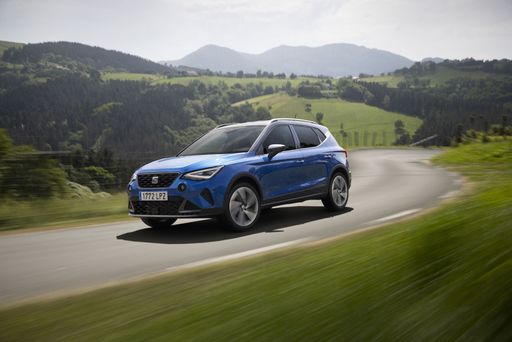 @ SEAT S.A. / SEAT Media Center
@ SEAT S.A. / SEAT Media Center
SEAT Arona
SEAT Arona
The SEAT Arona is a stylish compact SUV that blends urban agility with a robust design, making it an ideal choice for city dwellers and adventure seekers alike. Inside, it offers a well-crafted interior with modern technology and connectivity features that enhance the driving experience. With its efficient engine options and responsive handling, the Arona provides a dynamic ride while maintaining impressive fuel efficiency.
details @ SEAT S.A. / SEAT Media Center
@ SEAT S.A. / SEAT Media Center
 @ SEAT S.A. / SEAT Media Center
@ SEAT S.A. / SEAT Media Center
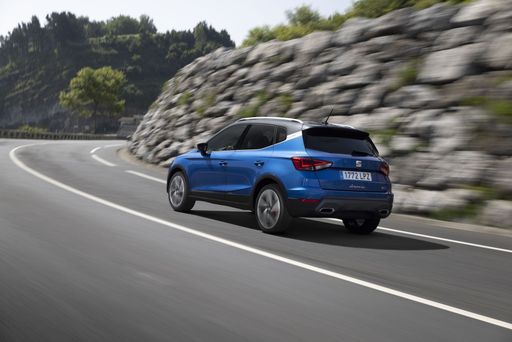 @ SEAT S.A. / SEAT Media Center
@ SEAT S.A. / SEAT Media Center
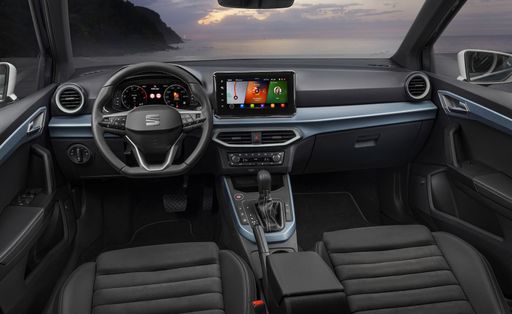 @ SEAT S.A. / SEAT Media Center
@ SEAT S.A. / SEAT Media Center
VW Taigo
Der VW Taigo besticht durch sein dynamisches Design, das sportliche Eleganz mit robusten Akzenten vereint. Im Innenraum setzt er auf modernste digitale Technologien, die dem Fahrer ein komfortables und vernetztes Fahrerlebnis bieten. Seine erhöhte Sitzposition sorgt für eine hervorragende Sicht und macht ihn sowohl für die Stadt als auch für längere Fahrten bestens geeignet.
details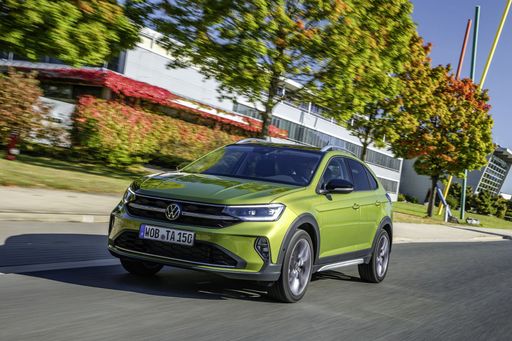 @ Volkswagen AG / VW Media
@ Volkswagen AG / VW Media
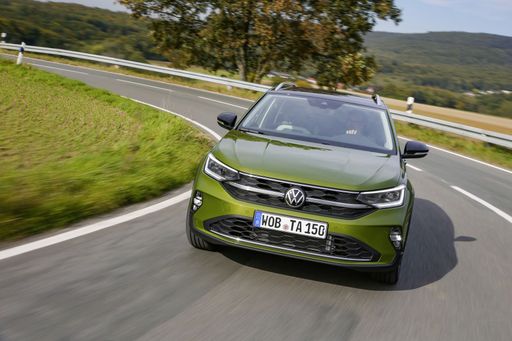 @ Volkswagen AG / VW Media
@ Volkswagen AG / VW Media
 @ Volkswagen AG / VW Media
@ Volkswagen AG / VW Media
 @ Volkswagen AG / VW Media
@ Volkswagen AG / VW Media
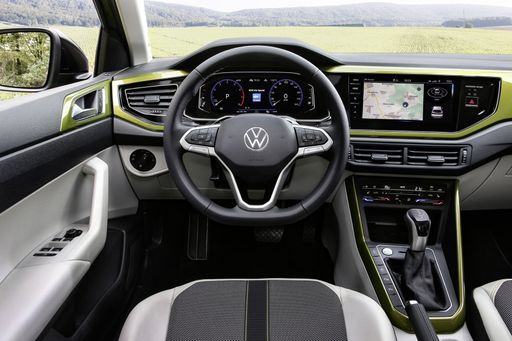 @ Volkswagen AG / VW Media
@ Volkswagen AG / VW Media
 @ SEAT S.A. / SEAT Media Center
@ SEAT S.A. / SEAT Media Center
|
 @ Volkswagen AG / VW Media
@ Volkswagen AG / VW Media
|
|
|
|
Costs and Consumption |
|
|---|---|
|
Price
19300 - 29300 £
|
Price
19600 - 31300 £
|
|
Consumption L/100km
5.4 - 5.6 L
|
Consumption L/100km
5.3 - 5.8 L
|
|
Consumption kWh/100km
-
|
Consumption kWh/100km
-
|
|
Electric Range
-
|
Electric Range
-
|
|
Battery Capacity
-
|
Battery Capacity
-
|
|
co2
122 - 128 g/km
|
co2
120 - 132 g/km
|
|
Fuel tank capacity
40 L
|
Fuel tank capacity
40 L
|
Dimensions and Body |
|
|---|---|
|
Body Type
SUV
|
Body Type
SUV
|
|
Seats
5
|
Seats
5
|
|
Doors
5
|
Doors
5
|
|
Curb weight
1188 - 1268 kg
|
Curb weight
1229 - 1302 kg
|
|
Trunk capacity
400 L
|
Trunk capacity
440 L
|
|
Length
4153 mm
|
Length
4266 mm
|
|
Width
1780 mm
|
Width
1757 mm
|
|
Height
1537 mm
|
Height
1518 mm
|
|
Max trunk capacity
1280 L
|
Max trunk capacity
1222 L
|
|
Payload
502 - 522 kg
|
Payload
448 - 457 kg
|
Engine and Performance |
|
|---|---|
|
Engine Type
Petrol
|
Engine Type
Petrol
|
|
Transmission
Manuel, Automatic
|
Transmission
Manuel, Automatic
|
|
Transmission Detail
Manual Gearbox, Dual-Clutch Automatic
|
Transmission Detail
Manual Gearbox, Dual-Clutch Automatic
|
|
Drive Type
Front-Wheel Drive
|
Drive Type
Front-Wheel Drive
|
|
Power HP
95 - 150 HP
|
Power HP
95 - 150 HP
|
|
Acceleration 0-100km/h
8.4 - 11.3 s
|
Acceleration 0-100km/h
8.2 - 11.1 s
|
|
Max Speed
182 - 210 km/h
|
Max Speed
184 - 212 km/h
|
|
Torque
175 - 250 Nm
|
Torque
175 - 250 Nm
|
|
Number of Cylinders
3 - 4
|
Number of Cylinders
3 - 4
|
|
Power kW
70 - 110 kW
|
Power kW
70 - 110 kW
|
|
Engine capacity
999 - 1498 cm3
|
Engine capacity
999 - 1498 cm3
|
General |
|
|---|---|
|
Model Year
2025
|
Model Year
2024 - 2025
|
|
CO2 Efficiency Class
D
|
CO2 Efficiency Class
D
|
|
Brand
SEAT
|
Brand
VW
|
Is the SEAT Arona offered with different drivetrains?
Available configurations include Front-Wheel Drive.
The prices and data displayed are estimates based on German list prices and may vary by country. This information is not legally binding.
